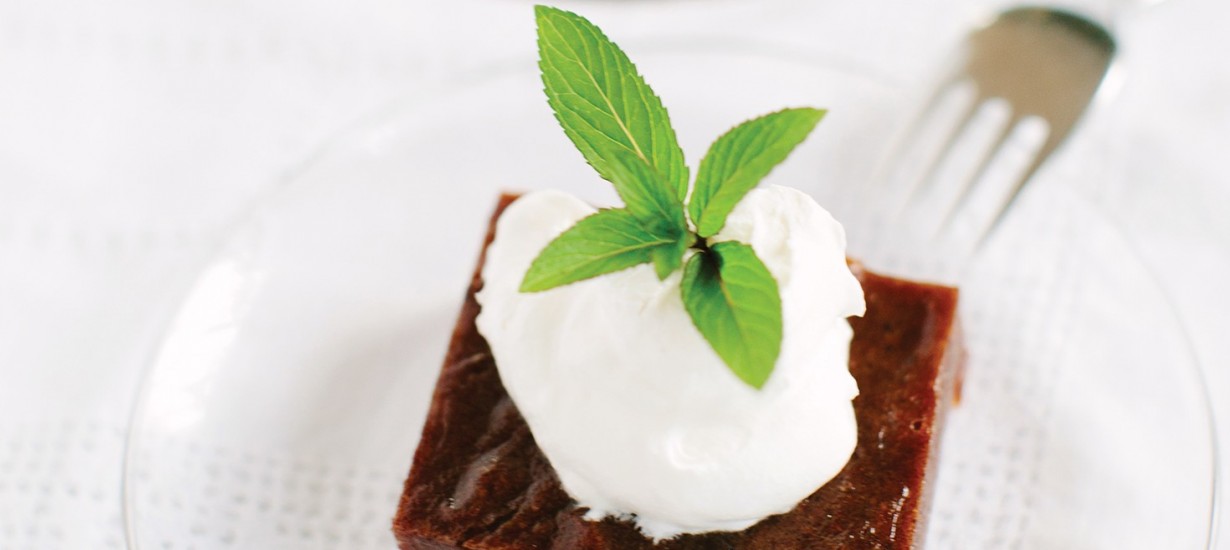Foraging for Persimmons

by Ray Linville ’67

Ray Linville ’67 writes and lectures about the American South. His posts about food and culture appear on the N.C. Folklife Institute’s NCFood blog that explores North Carolina’s traditional cooking and foodways. (Photo by Anna Routh Barzin ’07)
My family, when I was growing up, was fascinated with persimmons and the pudding that they make. We never planted a tree as someone might who would cultivate another fruit because we considered persimmons something Mother Nature provided. They were free for the taking — whether in a vacant yard or along a road.
My brother Wayne and I always waited until after the first frost to look for the fallen fruit. Frost reduces the persimmon’s bitterness. Otherwise, biting into a persimmon can bring a surprise. Capt. John Smith of Jamestown Colony fame observed that the fruit “will draw a man’s mouth awrie with much torment,” although he also admitted that when ripe it can be “as delicious as an apricot.”
My brother and I diligently handed over our persimmons to my aunt, the family caretaker and cook who moved in after my mother died. As we observed the skill she displayed in preparing persimmon pudding, we realized that it took years for her to hone her craft, and the joy that she experienced in making this treat was connected to family traditions when she was young. Her recipe dates back to the early 1900s.
Although gathering persimmons is easy, in the kitchen they are trouble, as I quickly learned when I was given the awful job (at least, for a child) of separating the pulp from the skin and seed. The task had become too arduous for my aunt, who continued to make persimmon pudding each fall until she passed at age 76.
The tools were basic. I would reach into the back of the lowest shelf in the kitchen, find a cone-shaped metal sieve (which hadn’t been used since the last time persimmon pudding had been made) and wash it. Then I would load a handful of persimmons into it and smash them against the side of the sieve with a large metal spoon. Slowly the pulp would begin crawling out of the sieve like little shoots sprouting from the ground in the spring.
Once the pudding was baked and cut into squares, the prized portions had a crusty edge formed by the pan’s hot sides. The person who had smashed the pulp got the first piece, and I always picked the one with the longest crust.
Although my daughter, Rachel ’98 (’01 MA), was born in Spain and my son, Russ, was born in Ohio, they inherited a fondness of persimmon pudding. Even my Minnesota-born wife adopted it as Thanksgiving tradition, and she would encourage the kids and me to find persimmons so that she could use the family recipe.
As our kids were growing up, we made trips at Thanksgiving to visit family in Winston-Salem. We would arrive the day before Turkey Day to scour the neighborhood for fallen persimmons. The next day we patiently waited for dessert time, and persimmon pudding always was more anticipated than all other items served.
In retirement now, I don’t jump at the chance to forage in vacant lots or smash persimmons in the kitchen. In fact, when I went to the annual persimmon festival in Colfax, I found pulp for sale and loaded up with enough to last several years. I know: It’s not the tradition. Buying pulp loses the thrill of the hunt and the opportunity to involve children in contributing to the holiday feast, but at least I know that enough pulp is available to serve pudding next fall.
When Rachel travels to North Carolina at Thanksgiving, she and I usually hike up the street by the “persimmon lot” near where I live. Last fall, she surprised us by making pudding herself late at night. Ah, the tradition continues.
Ray Linville ’67 writes and lectures about the American South. His posts about food and culture appear on the N.C. Folklife Institute’s NCFood blog that explores North Carolina’s traditional cooking and foodways. For more, go to www.ncfolk.org.
Persimmon Pudding
2 cups persimmon pulp
2 eggs
1½ cups milk
1 teaspoon vanilla
2 cups flour
1½ cups white sugar
1 teaspoon soda
¼ teaspoon salt
½ teaspoon nutmeg
½ teaspoon cinnamon
4 tablespoons butter
- Mix pulp, eggs, milk and vanilla.
- Sift dry ingredients and then stir into pulp mixture.
- Stir in melted butter.
- Bake at 350 F in greased 9-by-13-inch pan about 60 minutes or until a knife inserted in the pudding comes out clean.
Thanks for reading the Carolina Alumni Review
Carolina Alumni members, sign in to continue reading.
Not yet a member? Become one today.
